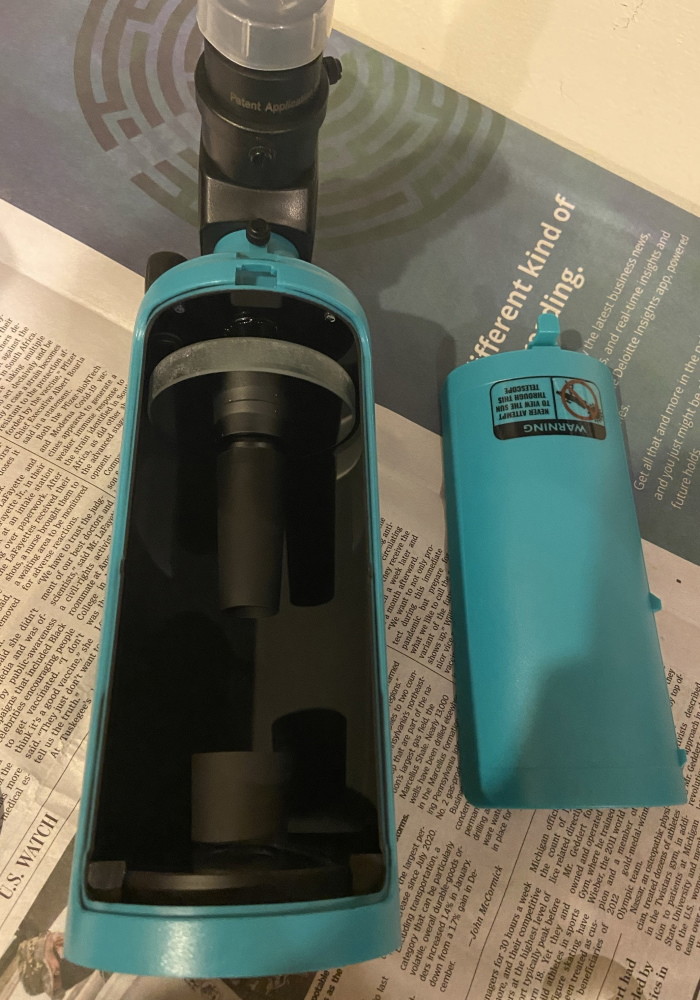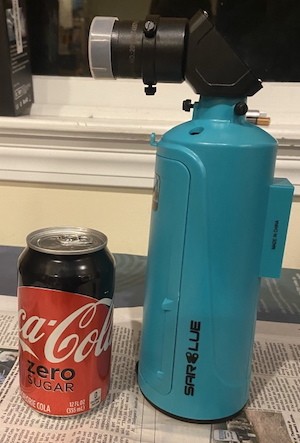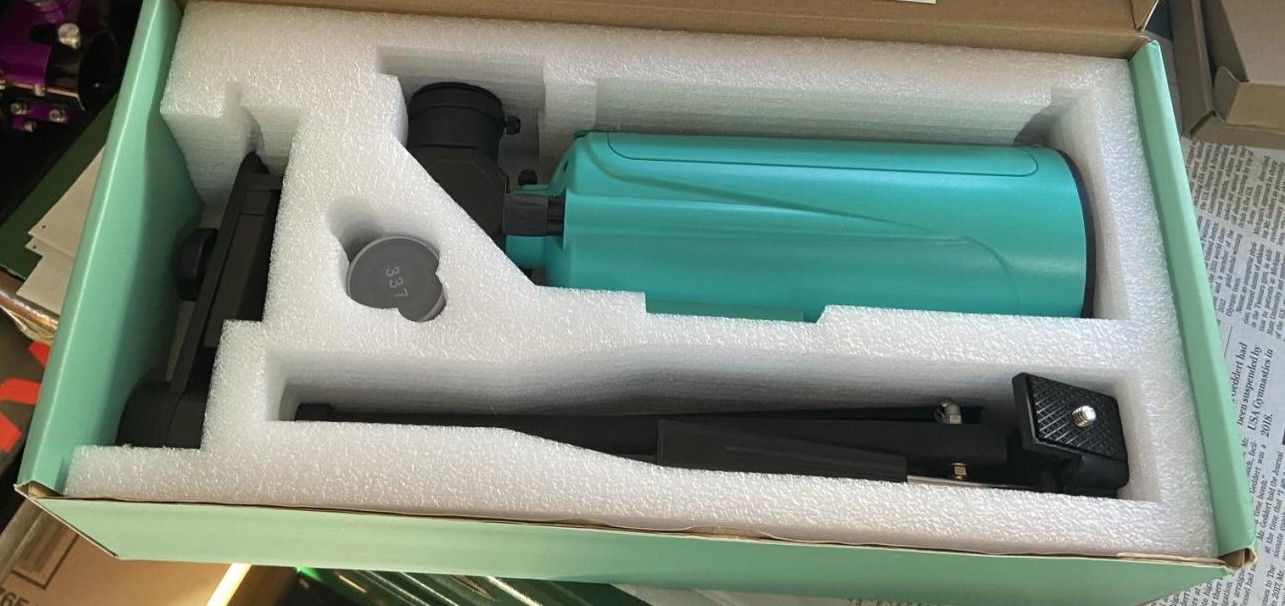The Optical Tube Overview of Sarblue 60
The Sarblue 60mm is a 60mm f/12.5 Maksutov-Cassegrain with a focal length of 800mm. 800mm isn’t considered a particularly long focal length for telescopes, but it is for one that you’re trying to aim purely with a pair of tiny nibs.
Those tiny nibs are the only sort of finder provided with the Sarblue—two protrusions molded into the polycarbonate plastic body of the scope. They do work, but take a lot of practice to use and aren’t very accurate. You will get really good at aiming a telescope with a proper finder if you get used to the Sarblue. The reasoning for this finder isn’t just cost—there’s simply not enough space on the tube to really attach a proper finder!
The Sarblue 60mm has the same baffles and moving-mirror focuser as a larger Maksutov- or Schmidt-Cassegrain telescope, with next to no image shift (in no small part thanks to the meager weight of the primary mirror, just a few ounces in total), and it’s overall surprisingly well put together. The plastic tube is stiff and sturdy and is not easily scratched. A portion of the tube lifts off and can be removed to view the optics and baffles inside and see how the whole thing works, a neat educational feature.

The back of the Sarblue 60mm has a 0.965” port, which is an outdated standard for inserting accessories. Thankfully, the included hybrid diagonal converts it to 1.25 inches—though it will vignette with longer focal length eyepieces as a consequence of this undersized port.

Accessories with Sarblue 60
The Sarblue 60mm Mak comes with one eyepiece: a 20mm Kellner yielding 40x. This eyepiece is fairly decent, although it lacks any sort of rubber eyeguard/eyecup, and you’ll obviously want more eyepieces for varying magnifications.
I’ve noticed the included star diagonal is a hybrid to fit the 0.965” port, and it uses an Amici erecting prism. Consequently, it produces an upright and correctly oriented left-right image, which will allow you to read signs from far away and so forth. But it’s pretty mediocre for astronomical viewing, producing an annoying diffraction spike on bright targets and gobbling a few extra photons from faint fuzzies that might otherwise reach your eyeball. However, many entry-level refractors come with far worse Amici diagonals at much higher prices, so it’s not much to complain about.
Lastly, the telescope also includes a pretty basic but solid smartphone adapter. It’s fun for taking photos of the Moon or terrestrial objects, and it fits most smaller 1.25” eyepieces, such as the included 20mm, if you take the eyeguards off.
The Tabletop Tripod Overview
The Sarblue 60mm Maksutov-Cassegrain telescope is supplied with a solid metal tabletop tripod. It can be a bit annoying to get a proper amount of tension in the mount to aim it with any appreciable degree of accuracy, let alone keep it there. As a result, combined with the tabletop nature and the lack of a real finder on the Sarblue, the included tripod is little more than a display stand. However, the scope is so lightweight that even a really low-quality photo tripod will suffice to support and aim it; you probably have something adequate in your home already or can find a suitable one for less than $20.
Keep in mind that even with a full-sized tripod, the Sarblue 60mm is so lightweight that attaching a phone to the back with the included adapter has a real chance of tipping the thing over or moving it off-target at the very least.
Should I buy a Sarblue 60mm Maksutov?
As long as the optics look clean and the housing isn’t cracked, there’s no reason not to.
Aftermarket Accessory Recommendations
The main extra item I’d recommend for the Sarblue 60mm, besides a steadier tripod of some sort, is a 6mm “goldline” eyepiece for 133x magnification, which is the most the scope can handle before running out of image brightness or resolution. A lower magnification like a 25mm or 32mm Plossl will vignette due to the Sarblue’s small baffle tube and thus should not be used.
What can you see with Sarblue 60mm?
The Sarblue 60mm is a small scope with a long focal length. It’s primarily optimized for the Moon, planets, and double stars but will show you a few deep-sky objects too.
Within the solar system, you’ll be able to see:
- The Moon: Lots of detail. We’ll leave it to you to be impressed by the views rather than try and convey them here.
- Mercury and Venus: Phases, though seeing Mercury’s might be a challenge.
- Mars: A dark spot or two and an ice cap around its opposition.
- Jupiter: Cloud belts, moons, and possibly the Great Red Spot if you have good seeing and a higher magnification eyepiece.
- Saturn: Rings, moons, possibly some dull cloud bands and the Cassini Division within the rings if you have good seeing and a higher magnification eyepiece.
- Uranus & Neptune: Star-like dots if you can even find them or identify them in the first place.
The 60mm aperture is fairly limiting when it comes to deep-sky objects, but there’s still a decent amount of stuff visible:
- Open star clusters: very sharp, albeit not the brightest.
- Globular star clusters: The brighter ones (mostly from the Messier catalog) are visible as fuzzy patches of moderate size. Dim globulars like M53 are all-but invisible to even experienced users.
- Nebulae: Bright, large emission nebulae like Orion and the Lagoon or Swan look surprisingly good if you have decent skies. Small planetaries like the Ring are little more than dim, tiny fuzzes, if they’re distinguishable from stars at all.
- Galaxies: Anything besides Andromeda and perhaps NGC 253 and M82 is extremely challenging to see at all, and detail in even the aforementioned three is really tough with anything but perfect skies.
The scope is also capable of splitting fairly tight double stars, down to about 2 arc seconds in separation. The Maksutov-Cassegrain design’s complete lack of chromatic aberration or diffraction spikes really helps with a scope this tiny being able to achieve the absolute limit of its theoretical resolution.




Thank you very much for this review.
One feedback to include a lot of photos and if possible videos/YouTube to understand narration better.
Can you also review their newly launched Mak70 model with 70mm aperture and 1000mm zoom I couldn’t find many professional reviews of it.
It’s hard to decide if its worth double the price for the optics quality upgrade.
It comes with tripod and finder scope though.
As a last thought, the price to optics combination of Mak60 is I think good for democratization of sky observation hobby which still in 2022 after 100s of years of Galileo a costly affair for many.